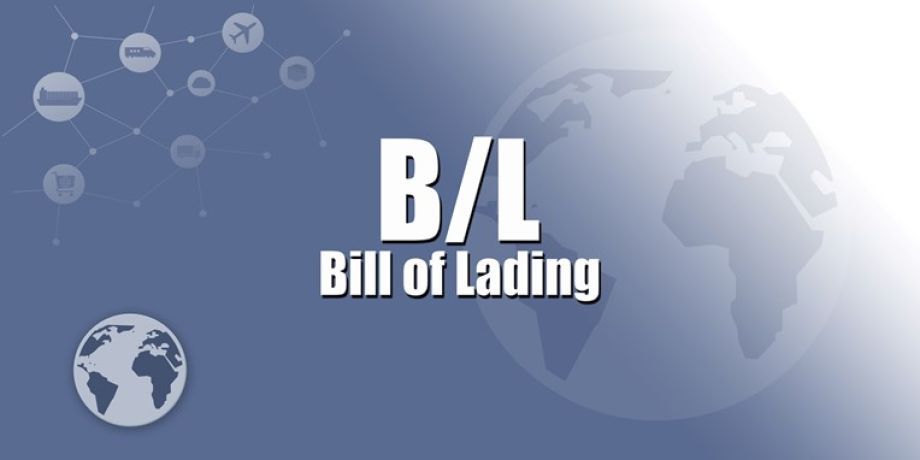
BILL OF LADING (BL) : ESSENTIAL DOCUMENT FOR TRANSPORTING YOUR GOODS BY SEA
All goods shipped by sea require a Bill of Lading (BL).
DEFINITION AND ROLES OF THE BILL OF LADING
The bill of lading has 3 functions:
1/ TRANSPORT DOCUMENT
This is the maritime transport contract signed between a shipper and a carrier (shipping company or freight forwarder). It is a legal document drawn up between these 2 parties which specifies the type, quantity and destination of the goods transported and determines who may dispose of them, as well as the responsibilities of all parties.
2/ LEGAL PROOF
It acts as legal proof that the goods have been properly received and taken over by the carrier. The carrier may therefore be held liable if the goods are damaged during transport.
3/ DOCUMENT OF TITLE REPRESENTING THE GOODS
It constitutes a document of title representing the goods for the shipper and for the consignee designated as the bona fide bearer of the document of title.
The BL is issued by a Shipping Company or a Non Vessel Operating Common Carrier (NVOCC). The latter is a shipping company that offers goods transport services without owning a ship. For example, a freight forwarder, who acts as an intermediary between the shipping company and the shipper.
TYPES OF BILLS OF LADING
There are different types of BL, the most commonly used being the Bill of Lading and the Sea Way Bill.
The original bill of lading:
This is a set of documents made up of 3 originals. The Bill of Lading may be negotiable if the consignee is “to order”. The holder of the BL has the right to dispose of the goods, sell them or transfer them to a third party in exchange for payment. If the consignee is named, the Bill of Lading is non-negotiable. Only the consignee named on the BL is authorised to collect the goods. This BL is known as “direct”. Today it is mainly used in 2 situations: as a guarantee of payment for the goods and for destinations where this type of BL is required (e.g. Brazil and Algeria).
The Sea Way Bill (SWB):
This type of document is non-negotiable. It can only be used by the named recipient. It is generally used when it is not necessary to protect the payment of an invoice (regular customer, for example). It may be in electronic format.
The EBL:
Dematerialised version of the original BL. Unlike the SWB, it remains a negotiable transport document, but the releases are made electronically, which makes processing more secure and faster.
However, some banks (for documentary credits) and some countries do not yet accept it.
Special features of the NVOCC Bill of Lading:
As an NVOCC, the transport company can issue a House Bill of Lading (HBL). This represents the maritime transport contract between the freight forwarder and his customer. It can be issued in either original or electronic format (see explanation of the 2 types of HBL). It is used in particular when the freight forwarder wants to involve one of his agents to secure his shipment if the country of destination of the goods so requires. In the case of an HBL, the transport document drawn up between the shipping company and the freight forwarder is called the Master Bill of Lading (MBL), which can also be issued in original or electronic format.
In a nutshell:
MBL: Contract of carriage between the shipping company and the freight forwarder.
HBL: Contract of carriage between the freight forwarder and his customer.
INFORMATION ON THE BL
Drawn up in several copies, the BL must contain all the information required for transport, including details of the shipment, the goods and the parties involved:
- Bill of Lading number
- Type of Bill of Lading
- Name of vessel, Voyage number
- Ports of departure and arrival
- Name and address of: Shipper / Consignee / Notifier
- Date of shipment of goods on the vessel
- Place and date of issue of Bill of Lading
- Description of goods (quantity, type of packaging, weight, volume, nature of cargo)
- Method of freight payment: prepaid or collect
- If transported in a container, its number will be noted as well as its type and seal number
- If multimodal transport, then the place where the goods are picked up and/or delivered is mentioned
- If the Bill of Lading is an original, the number of originals issued
THE USE OF BL
If original BL:
On arrival, the consignee named on the B/L or the bearer of the latter (via a letter of release written by the consignee named on the B/L), must present an original to the shipping company, duly regularised (i.e. signed + commercial stamp). In exchange, the shipping line will issue a delivery note to the B/L consignee or bearer, allowing them to collect their goods at the port of arrival.
Once the first original of the B/L has been settled, the other originals become null and void. The Company is therefore released from its liability towards the shipper and/or the bearers of the other original B/Ls, even if they are acting in good faith.
If Sea waybill:
On arrival of the goods, the consignee named on the B/L or the bearer of the latter (via a letter of release written by the consignee named on the B/L), must make a claim with the shipping company to obtain the GTD (Good to deliver) which will enable him to collect the goods.








